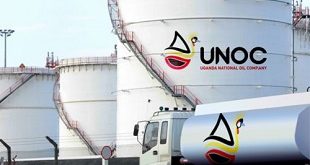
Uganda has moved another step closer to tapping its first oil by signing a memorandum of understanding[MOU] with all the oil companies currently involved in developing the country’s oil resources.
The conclusion of the MOU which was signed on Feb.5 by the government and the Chinese National Oil Offshore Company (CNOOC), Total E&P Uganda and Tullow Operations Pty Limited and Tullow Uganda Limited is another significant step for Uganda as it straightens the roadmap for the commercialization of the petroleum resources.
Irene Muloni, the Minister of Energy and Mineral Development told a group of journalists on Feb.6 that the memorandum will now provide a framework for achieving a ‘harmonized commercialization plan for the development’ of Uganda’s petroleum.
According to Muloni, the comprehensive plan will include the use of the gas resources for power generation, supply of crude oil to the refinery expected to be developed within Uganda [by the government] and the export of crude oil through an export pipeline [by the oil companies].
The memorandum requires oil companies to support the government in its efforts to develop the refinery on one hand while on the other, it calls upon the government to provide support to the oil companies in acquiring approvals for studies and surveys for an export pipeline and to initiate discussions with neighbouring countries in relation to cross border frameworks for the pipeline.
The signing of the memorandum is now expected to increase the pace at which the country’s oil resources will be developed following years of frustrating negotiations between the government and the oil companies.
Uganda discovered crude oil in 2006 but its citizens have been left guessing when exactly the oil dollars would get into the economy to help the government reduce the alarming poverty levels.
Muloni said government shall develop a refinery with an initial input capacity of 30,000 barrels per day, expected to be upgraded to one able to produce 60,000 barrels a few years later, while the partners will be expected to develop a pipeline or any other viable option to export crude oil.
Muloni said she expects the country to start producing electricity using its vast gas resources by 2015 while the refinery should be in operation by 2017.
However, she added that the refinery shall have the right of first call on production volumes from the licensed areas.
“In the short term, prior to the refinery coming on board, the oil companies will supply crude oil from the contract areas to be used for power generation,” she said.
The commercialization plan is based on the current discovered recoverable reserves in the country estimated to be in the range of 1.2-1.7 billion barrels of crude oil.
The memorandum also provides for the expansion of the refinery beyond 60,000 barrels per day in the event that additional resources are confirmed in the licensed areas.
The government is taking forward the development of Uganda’s refinery and is now acquiring 29 sq km of land in the western Albertine-area district of Hoima for the project through implementation of a resettlement action plan.
In addition, six firms and consortia were short-listed last December to submit proposals for the development of the refinery and among the six; one will be selected as a lead investor or operator for the development, implementation and operation of the refinery and related downstream infrastructure.
The refinery is expected to be operated under the Public-Private Partnership model with the private investor expected to own up to 60% of the project, while the rest will belong to the government and any other entity within the East African Community interested in being a part of the project.
The short-listed firms include; a consortium led by the China Petroleum Pipeline Bureau; Marubeni Corporation (Japan); and another consortium led by the UK-registered Petrofac.
The other consortia include one led by the Russian-based RT – Global Resources; the South Korean—based SK Energy; and Vitol—a Dutch-owned company.
Muloni said, the government will decide by the middle of this year which consortium will lead the refinery development.
“The signing of the MOU is therefore a significant step towards the production of Uganda’s discovered oil and gas resources,” she said.
Now that an agreement has been reached on how best to exploit the resources, the three oil companies are now expected to embark on an implementation plan with government.
In September, last year, the government issued a production licence over the Kingfisher Field operated by CNOOC and the company has now commenced the development of the field which is expected to take a period of four years before production starts.
Meanwhile, the energy ministry is reviewing applications for production licences over eight discoveries in Exploration Area2 operated by Tullow, and another application has been submitted by Total for another field in Exploration Area1.
Muloni reiterated that the government is ensuring that the process leading up to the development and production of the discovered resources are handled efficiently and effectively, in line with the country’s oil and gas policy.
“The government is very keen to develop the oil resources now that we have agreed on how best to do it,” Muloni said, insisting that the government wants to do this in the most transparent and accountable manner to bring lasting value to the country.
 The Independent Uganda: You get the Truth we Pay the Price
The Independent Uganda: You get the Truth we Pay the Price


